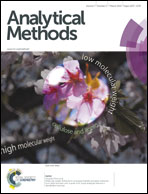Selective extraction of light polycyclic aromatic hydrocarbons in environmental water samples with pseudo-template thin-film molecularly imprinted polymers†
Abstract
An interesting approach to environmental analysis of trace level contaminants in the environment is molecular imprinting. This article describes the fast, low-tech preparation and evaluation of thin-film molecularly imprinted polymers (MIPs) for the specific uptake of light polycyclic aromatic hydrocarbons (PAHs) from complex aqueous matrices. Detection is carried out using offline gas-chromatography-mass spectrometry (GC-MS). The use of toluene as a pseudo-template eliminates the problem of positive errors associated with incomplete template removal when the template and analyte are identical. These MIPs give a linear response in standard aqueous solutions and spiked wastewater over a concentration range of 10 to at least 100 μg L−1, and superior selectivity over the non-imprinted materials. In MIP uptake studies for PAHs at environmentally relevant concentrations in spiked seawater samples, linearity was obtained over the range studied (0.5–5 μg L−1) with R2 values from 0.978 (naphthalene) to 0.997 (pyrene). Other than addition of standards for calibration, all environmental samples were used unmodified. Good recoveries owing to good selectivity, good response linearity and a good uptake trend overtime indicate these materials are suitable for in situ monitoring or remote monitoring.


 Please wait while we load your content...
Please wait while we load your content...